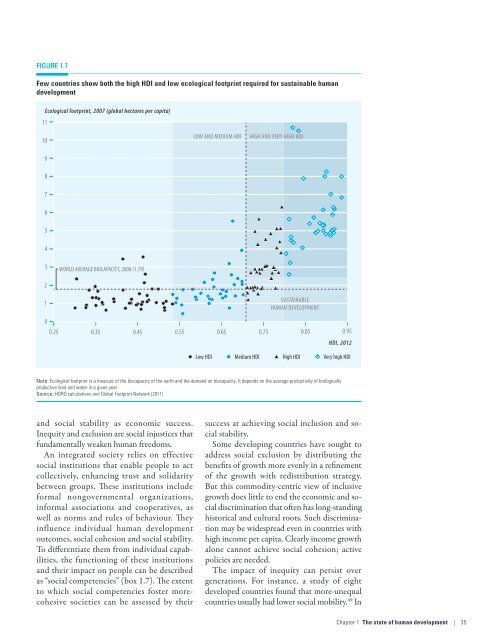E S N W
E S N W
E S N W
You also want an ePaper? Increase the reach of your titles
YUMPU automatically turns print PDFs into web optimized ePapers that Google loves.
FIGURE 1.7<br />
Few countries show both the high HDI and low ecological footprint required for sustainable human<br />
development<br />
11<br />
10<br />
Ecological footprint, 2007 (global hectares per capita)<br />
9<br />
8<br />
7<br />
6<br />
5<br />
4<br />
3<br />
2<br />
1<br />
0<br />
WORLD AVERAGE BIOCAPACITY, 2008 (1.79)<br />
0.25 0.35 0.45 0.55 0.65 0.75 0.85 0.95<br />
and social stability as economic success.<br />
Inequity and exclusion are social injustices that<br />
fundamentally weaken human freedoms.<br />
An integrated society relies on effective<br />
social institutions that enable people to act<br />
collectively, enhancing trust and solidarity<br />
between groups. These institutions include<br />
formal nongovernmental organizations,<br />
informal associations and cooperatives, as<br />
well as norms and rules of behaviour. They<br />
influence individual human development<br />
outcomes, social cohesion and social stability.<br />
To differentiate them from individual capabilities,<br />
the functioning of these institutions<br />
and their impact on people can be described<br />
as “social competencies” (box 1.7). The extent<br />
to which social competencies foster more-<br />
cohesive societies can be assessed by their<br />
LOW AND MEDIUM HDI HIGH AND VERY HIGH HDI<br />
Low HDI<br />
Medium HDI<br />
SUSTAINABLE<br />
HUMAN DEVELOPMENT<br />
High HDI<br />
HDI, 2012<br />
Very high HDI<br />
Note: Ecological footprint is a measure of the biocapacity of the earth and the demand on biocapacity. It depends on the average productivity of biologically<br />
productive land and water in a given year.<br />
Source: HDRO calculations and Global Footprint Network (2011).<br />
success at achieving social inclusion and social<br />
stability.<br />
Some developing countries have sought to<br />
address social exclusion by distributing the<br />
benefits of growth more evenly in a refinement<br />
of the growth with redistribution strategy.<br />
But this commodity-centric view of inclusive<br />
growth does little to end the economic and social<br />
discrimination that often has long-standing<br />
historical and cultural roots. Such discrimination<br />
may be widespread even in countries with<br />
high income per capita. Clearly income growth<br />
alone cannot achieve social cohesion; active<br />
policies are needed.<br />
The impact of inequity can persist over<br />
generations. For instance, a study of eight<br />
developed countries found that more-unequal<br />
countries usually had lower social mobility. 49 In<br />
Chapter 1 The state of human development | 35


